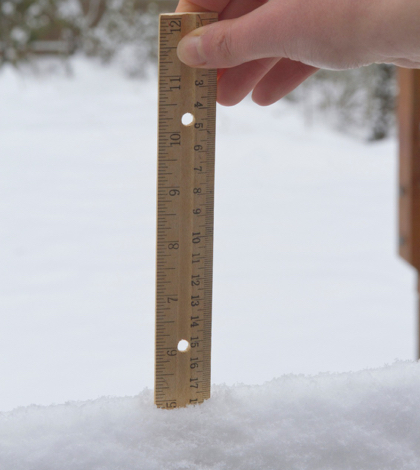Is California headed for another drought? Early season indicators do not bode well for the thirsty state after Thursday’s monthly manual snow survey east of Sacramento at Phillips Station.
“The snow survey today shows water content far below average for this time of year,” said Frank Gehrke, chief of the California Cooperative Snow Surveys Program who conducted Thursday’s survey at Phillips. He appeared hopeful for the remainder of the traditional snow season saying, “Today’s measurements indicate an anemic snowpack to date, but there is still the possibility of a wet February and March.”
Tuesday’s manual snow survey, traditionally measured on the first few days of the first four months of the calendar year, revealed a snow water equivalent (SWE) of 2.6 inches, 14 percent of the early-February average at Phillips Station as measured there since 1964. SWE is the depth of water that theoretically would result if the entire snowpack melted instantaneously.
The Department of Water Resources (DWR) conducts on-going electronic readings from 103 stations scattered throughout the Sierra. These readings provide a more accurate and comprehensive than the monthly manual survey at Phillips Station. To date measurements reveal the SWE for Feb. 1 in the northern Sierra snowpack is 4.6 inches, 27 percent of the multi-decade average. The central Sierra reading is 5.8 inches or 30 percent of average while the southern Sierra reading is posted as 3.8 inches or 25 percent of average. Statewide, the snowpack’s SWE is 4.9 inches, or 27 percent of the Feb. 1 average.
More than 250 manual surveys, including Phillips Station, are conducted by DWR throughout the winter. Manual measurements augment the electronic readings from the snow pillows in the Sierra Nevada that provide a current snapshot of the water content in the snowpack.
The California snowpack annually provides about 30 percent of the state’s water needs, on average. The larger the snow melt in the spring and early summer, the greater the probability that California will receive the ample runoff to support the state’s water demand in the summer and fall. If the lack of snowfall continues this winter the state will inevitably look to the exceptionally high precipitation from last winter and spring that resulted in above-average storage in 154 reservoirs tracked by the DWR. The department estimates total storage in those reservoirs at the end of January was 24.7 million acre feet (MAF) or 106 percent of the 23.4 MAF average for this time of year.
“California experiences the most variable weather in the nation,” said DWR Director Karla Nemeth. “It’s vital that water conservation efforts remain consistent regardless of the year’s precipitation.”
 California Water News Daily Your Source For Water News in California
California Water News Daily Your Source For Water News in California


